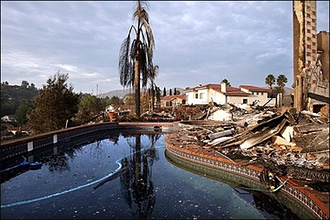 |
 |
 |
 Editorials | Issues | October 2007 Editorials | Issues | October 2007  
Wildfires Raise Questions With No Easy Answers
 dpa dpa
go to original


| | The remains of a destroyed home are seen 27 October 2007 in Rancho Bernardo, California. (AFP/Spencer Platt) |
In an era when global warming is mixing hotter summers with drier winters, what could be more foolhardy than promoting a building boom in one of the most wildfire prone zones in the US?

Plenty, it turns out.

As firefighters Monday were putting out the last embers of the blazes that devastated much of southern California last week, investigations and accusations were pointing the spotlight at numerous other factors that exacerbated the situation and could create the potential for a future firestorm that could make last week's events pale in comparison.

To be sure, for those impacted by the deadly infernos there was nothing trivial about them. More than 2,000 homes were reduced to mounds of ash and rubble, hundreds of thousands of people were forced from their homes and 12 people died in fire-related incidents. Insurance groups estimate the damage at around 1.5 billion dollars.

The temptation is to place the blame on the fickle behaviour of Mother Nature. But doing so ignores the multitude of human decisions that created the perfect conditions for fires to thrive, says Ellis Clarkson, an environmentalist and fire control specialist.

"(Governor Arnold) Schwarzenegger called it 'the perfect firestorm' but if the present trends continue this will be the norm in California," Clarkson said. "And that's not even thinking about the earthquakes."

On the most basic level, over a century of drastic wildland fire suppression in California created a huge stock of deadwood and other combustible fuel that ignites instantly and burns furiously.

In neighbouring Mexico, wildfires are generally allowed to burn their course. So as the same Santa Ana winds pounded southern California and its Mexican neighbours the results were starkly different: 25 hectares and three tourist cabins in Mexico, versus almost 200,000 hectares and 2,000 houses in California.

Another part of the deadly California formula is the building boom that sees thousands of homes going up each year as Americans seek their paradise in the regions famously scenic wildlands. According to a University of Wisconsin study, had last week's fires burned in the same locations in 1980, about 61,000 homes would have been within a mile of a fire. By 2000, the number would have grown to 106,000 homes, and this year it was 125,000.

Then there are the building codes, which until very recently paid very little attention to constructing homes to withstand wildfires. In a region rich with forests it's perhaps understandable that most houses are built mainly from wood. But it was only after the disastrous fires of 2003 that state and local officials began to get serious mandating the use of fire resistant materials for the roof and exterior walls, as well as interior sprinklers and other features.

The dramatic effect of these regulations was highlighted in the community of Rancho Santa Fe, where five subdivisions built with stringent safety requirements emerged unscathed even as surrounding homes burnt down.

The communities used an Australian-developed concept called "shelter-in-place" that requires indoor fire sprinklers, noncombustible roofs, wide roads and driveways for firefighting equipment and 30 metres of defensible space around homes with irrigated, fire-resistant plants.

But all that will mean little unless local and state governments in California begin to implement their own recommendations and spend a lot more on firefighting. For instance, officials recommended the purchase of 150 new firetrucks after the 2003 fires in San Diego. Four years later, 19 have been ordered and none have been delivered.

In Orange County, one of the hardest hit areas, there is so little money devoted to firefighting that there are only three firefighters per truck rather than the recommended four.

Low staffing meant that there was no chance to put out fires while they were still small. A string of bureaucratic wrangling also prevented sufficient firefighting aircraft from attacking the fires before they had become too large.

Local and state leaders have dismissed much of the criticism at the same time as they promise to implement lessons learned last week.

But Max Moritz, a wildfire expert at the University of California at Berkeley is a little skeptical. "Unfortunately it seems like we keep relearning some of the lessons that we probably should have implemented already." | 
 | |
 |



